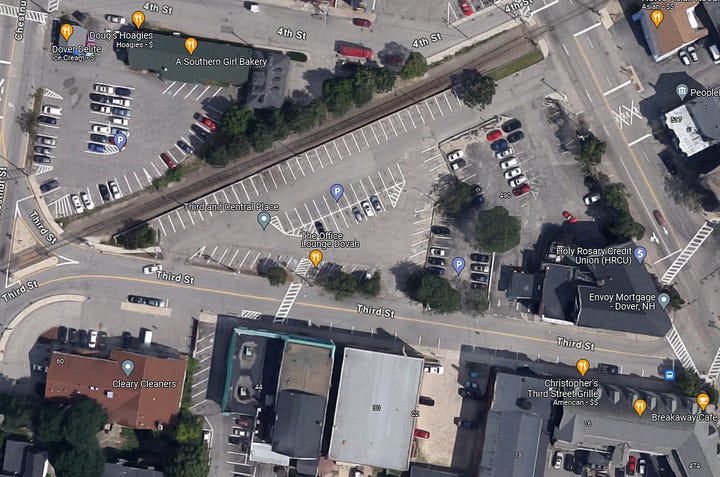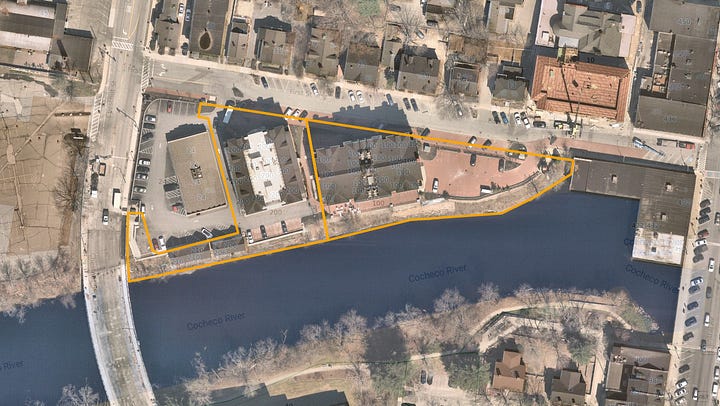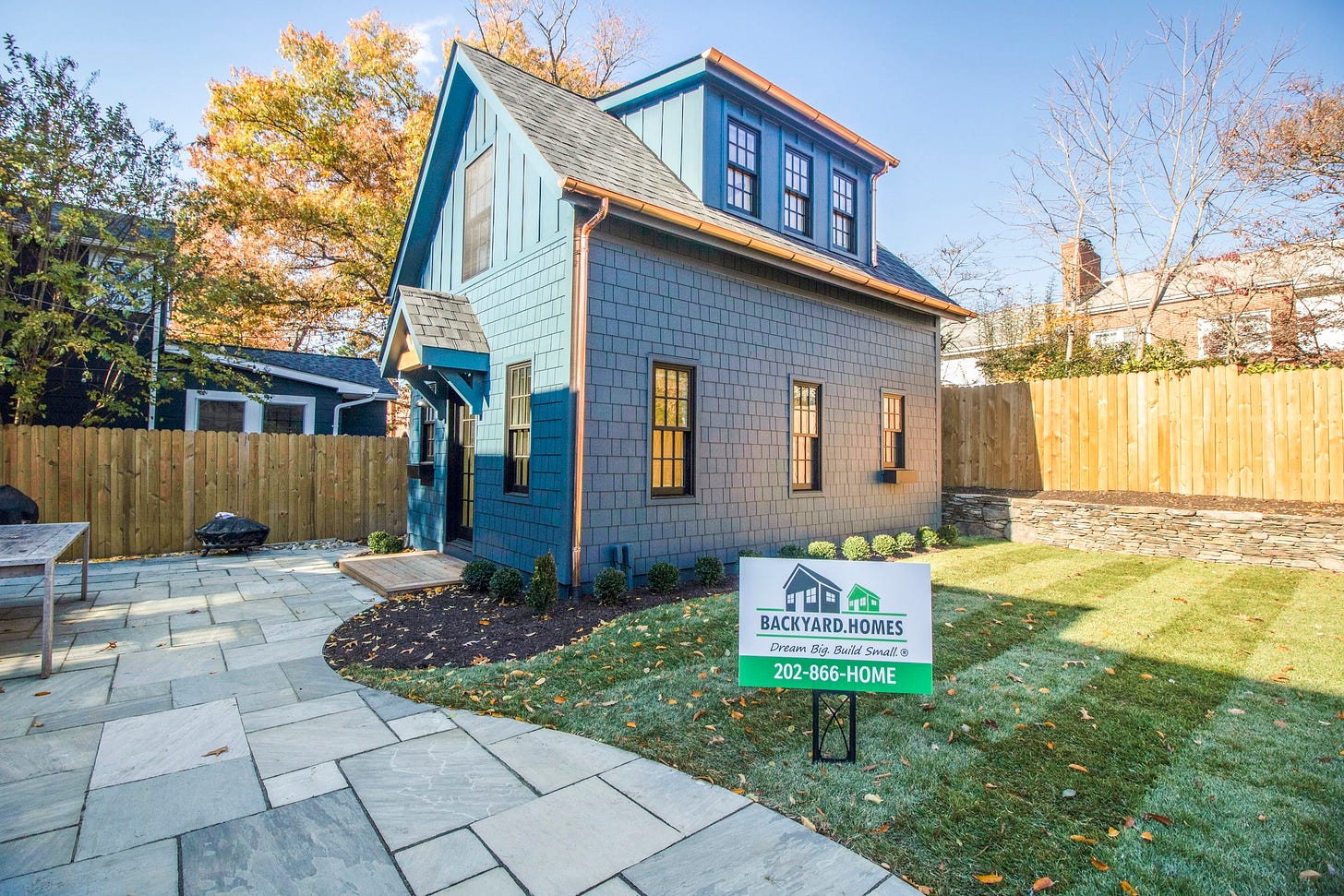Infill Development Gives Communities More Bang for Their Buck
Filling in empty, passed over, or underutilized land in our most productive areas let's us increase our community wealth without having to buy expensive, new infrastructure
Thank you for reading the Strong Towns Seacoast Newsletter. My sister, her husband, and their two daughters just came to visit our section of the United States from their home in Alabama and we had a great time showing them around the Seacoast. We checked out Lickee’s and Chewy’s, The Noggin Factory, ate at Lexies in Dover, La Festa, and treated ourselves to Dover Delight. If you’re curious what they enjoyed the most on their visit, Durham House of Pizza and Monkey Mind Games in Portsmouth (my youngest niece solved the final puzzle!) were highlights and my brother-in-law’s search for new coffee shops led him to Two Bees and Breakaway Cafe. There was a lot more that we wanted to show them, but one week just wasn’t enough to see everything, especially with Boston and Portland each taking their own days. Just a reminder that we have a lot of great things to offer in the Seacoast.
Before we get to our topic I wanted to share details for our next meeting. We were recently added to the Dover Public Library’s calendar, and as part of that we have solidified our schedule. From now on we will be meeting on every third Saturday of the month at the Dover Public Library’s Learning Center Room.
Meeting #10 Details
Saturday, June 21st
10:30AM - 12:00PM
Learning Center at Dover Public Library
We will be broadly discussing zoning at our next meeting, what it is, how it is used and enforced, and in what ways it helps or hurts communities. I hope that you will join us in person and help us promote sustainable development patterns in the Seacoast region.
What is Infill Development?
I want to discuss an idea that helps communities increase the value of unproductive space that is around them. You take areas that are mostly empty or have been identified as underutilized, but already have infrastructure surrounding them and you fill it in with new development. This pattern is commonly referred to as “infill development” and it helps communities leverage their current infrastructure investments to get more use out of the land.
In the book Walkable City: How Downtown Can Save America One Step at a Time the author, Jeff Speck, refers to empty places like this as “missing teeth” in a downtown. You will be walking through a downtown passing by all sorts of shops, restaurants, and attractions when you come across a gap in between the buildings with just a few parked cars on an asphalt lot or perhaps nothing of interest at all. This is where infill development can help us get more from our already-made public investments in underused places.
How Infill Builds Community Wealth
Downtowns can greatly benefit from having additional investment and activating vacant properties, but this pattern is useful in many other areas as well. First, let’s examine the benefits to a downtown environment and I’ll use a property that we looked at in our last post to start with.


Third and Central Place is a mixed-use building in downtown Dover that was built in 2019, prior to that it was a parking lot. Parking lots provide no residential units nor do they provide commercial units, just temporary storage for vehicles. The new building adds 23 residential units and 2 commercial units to this location. I don’t have the appraised tax value for the years before 2019, but the current appraised value of just the building alone is over 6 million dollars. That’s new housing, new businesses, new jobs, and higher taxable value, that is now helping to pay for your schools, your streets, and your parks.
That is how infill can make a positive difference in your community. It converted an underutilized area into a more productive one all while leveraging the significant public investment that surrounded the original parking lot. I’m sure there was some level of additional investment made to help this project become a success, but if you compare this type of development to building let’s say a new subdivision of 23 single family homes, the city is avoiding taking on maintenance for new streets, new sewer, and new water infrastructure in a big way.


Let’s look at one more example and see just how much more value this pattern can create for our communities. There are two riverfront properties that are relatively new in Dover and were also formerly parking lots. These are 100 and 200 First Street, where Two Bees Cafe is located. Again, as a parking lot we had a bunch of zeroes for residential and commercial units, but these new developments offer a total of 66 residential units and 2 commercial units and have a combined assessed building value of over 16 million dollars.
Infill Can Be Incremental
While the two examples I shared are large projects that are not within reach of the average person, we can make infill a part of other areas. This comes in the form of ADUs (Accessory Dwelling Units), adding on another room to your house, or putting a small neighborhood shop on your property. Small, incremental investments like this can allow our neighborhoods to grow over time and provide more value to our communities.
One of the risks of large infill projects or too much infill too fast is that the value of the area can outpace the wealth of residents who live there. This is one of the causes of gentrification, which is a much larger topic that we won’t be diving into for this newsletter. However, if we allow and encourage our current residents to be the primary investors of infill development, then we can let those resident’s wealth grow alongside the value of the neighborhood.
Challenges With Infill
Some of the barriers to infill development come from zoning policies, approval processes, and even community sentiment. Each of these needs to be tackled in their own way, but there are also places that infill is not appropriate. Some rural areas (such as farms) and especially high speed roads or highways can be negatively impacted by sudden increases in development along them. Our roads provide value to us by decreasing the time it takes to get between places, and adding developments along that infrastructures creates additional complexity that can begin to increase travel times (think of needing to add traffic signals to an area because a new store opened).
The political barriers can be mitigated with what is called “as-of-right” development. This method bypasses most approval processes by allowing people wishing to create new developments to avoid having to ask the city for permission to move forward. The necessary permits and zoning restrictions still need to be met, but there is little friction to getting started once you have those. Cities and towns can also help this process by creating pre-approved designs for residents to use or by reducing some zoning restrictions to allow for more freedom in development.
The social barrier can be more difficult and sometimes communities have a good understanding of what will and won’t be welcome within them. While some people might call such disapproval “NIMBYism”, I think it is important to engage with the push back and to not dismiss it. I don’t have a silver bullet suggestion for this one, my only advice is to build relationships and trust with the people pushing back on your proposed development and understand their concerns. Work with them towards a solution.
Conclusion
Infill development can be intimidating, especially with large projects that threaten to change the feeling or character of a neighborhood and we should be wary of that. Though, it is important to recognize that in lots of places it can add vibrancy and charm to a neighborhood and if done well, can also increase the wealth of the residents in a community. I hope that this has helped you think about where your community could benefit from some infill development and possibly even has you asking the question, “Are these parking lots the best use of our community’s land?”
Thank you for reading and I hope to catch you at our next in-person meeting at Dover Public Library!




